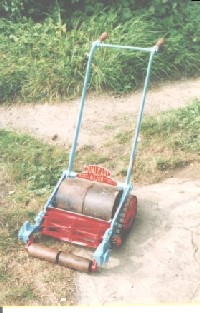

Times remained difficult for the manufacturers of lawn mowers and it took many companies until 1920 before they could resume their pre-war activities. In many cases the stocks of lawn mowers on sale were actually made before the war plus spare parts were very scarce, especially for the imported machines.
Around this time Burgess of Brentford embarked on the latest craze - motor conversion kits for hand-powered machines. Other notable companies involved in this area were Nash of Wandsworth, London, Youngs of North London and MP Company of Oxford Street, London. The latter concern, being the sister company to Ransomes, were the most successful. The MP conversion kit came in three engine sizes, the K, L and M, and consisted of a Villiers engine mounted in a frame which drove a set of land wheels. The operator sat on top of the unit frame which would be attached to the rear of any make of hand push mower. On the larger units a roller could be towed at the same time.
In America a Mr Worthington, in 1914, had developed and patented a new machine to help with the maintenance of large grass areas. He had three side-wheel mowers connected together by a frame which was pulled by a horse. They were known as mower units and it was soon found that other units could be added to increase the cutting path. In 1920 Ransomes gained a licence to produce these 'gang' mowers in Britain.
Up until 1919 the engines used for motor mowers had chain- or gear-driven magnetos to provide the required ignition. Villiers were well-known cycle component makers and by 1913 had produced their first engine based on magneto ignition. In 1919 a young engineer, Frank Pountney, joined the company and later went on to develop the flywheel magneto. The magneto was developed so that the coil and points were placed inside the flywheel with the magnets to produce an electrical field on the concave section of the flywheel. This idea, resulting in a bigger spark at low speeds, proved a great success and was patented in 1919.
This engine soon became very popular with lawn mower manufacturers because it meant lighter, smaller and more easily managed models could be produced. Ransomes used the Villiers engine in their 18in and 20in fine turf models while Shanks used it in their equivalent machine, the 20in Jehu. Greens, however, did not follow suit as they were producing engines to their own design. The Atco company, the greatest users of Villiers engine, did not enter the field until 1920.
Charles H Pugh had a factory in Birmingham, the Whitworth Works, where they specialised in the repetition industry, making many parts for the textile and cycle trades. In 1920 Charles H Pugh entered the field of the lawn mower, producing a machine with a 22in cut, powered by a Villiers engine and costing £75. The machine's frame was made of cast iron because the company's own malleable iron foundry was on strike. A catchy name was needed for these machines. Charles H Pugh owned the Atlas Chain Company which just so happened to have the registered name of 'Atco', although at that time not used commercially. This soon changed for, by the end of 1920, the name of Atco had been registered all over the world.
By 1922 the prices of Atco mowers had been reduced and a system of deferred payments had been introduced. By the end of 1922 Atco had set up their own network of service depots, spanning the country. The first of these were at Eckington, nr Sheffield, Reading and Exeter. 1923 saw Atco extend the range of mowers to include the 16in and 30in models.
In the hand-powered market there was another new company producing machines of a side-wheel type, similar to Follow & Bates. This company, the Derwent Iron Foundry, from 1920 had the registered trade name of Qualcast, a name derived from the quality of their castings. One main reason Qualcast managed to get a foothold was the Board of Trade's ruling on foreign imports.

Dennis of Guildford, well-known in the field of commercial transport, produced a motor mower in 1921. It was not a great success and the design based on aluminium castings was dropped later that year. They were to reappear in 1923 with an entirely new design, well-advanced for the period.

The frame of this mower was of sheet steel construction which was far more expensive to produce than malleable iron. The original 24in model was joined in 1924 by a 30in machine.
The Dennis machines were built for heavy duty work and soon gained a market with councils and government departments. More relevant, however, was that Dennis had already achieved a good name for their other products, namely buses.